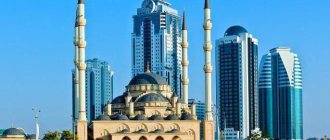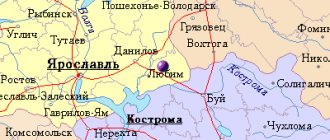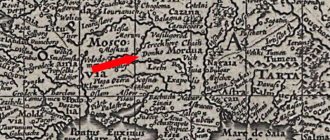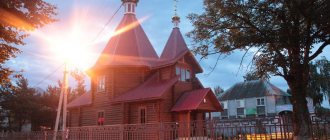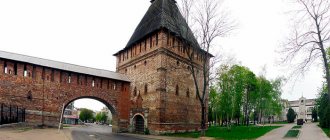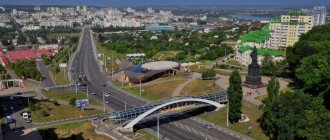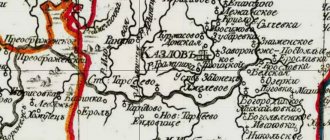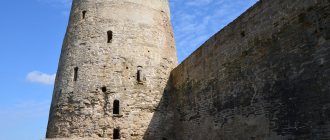Sergei Rubtsov
Tula traveler Sergei Rubtsov visited Grozny and talks about his impressions. This is not the first gulbarium about the capital of the Chechen Republic, so if you want to compare Grozny 2017 and Grozny 2019, you have this opportunity. And who knows, maybe you’ll want to do it in reality yourself
This is not the first gulbarium about the capital of the Chechen Republic, so if you want to compare Grozny 2017 and Grozny 2019, you have this opportunity. And who knows, maybe you’ll want to do it in reality yourself
— I very often come across information on the Internet that Grozny occupies top places in various city rankings. At the same time, I didn’t personally know people who went there, and most of the pictures show only postcard views of the city. But this spring I decided to see for myself what the “add any word” city in Russia actually looks like. Below there will also be mainly postcard views, but I will try to dilute them with my impressions of the city as a whole. I'll start from the very beginning.
The will and mind of the Russian general
Article on the topic Grozny Yarmul: how General Ermolov developed the Caucasus
By 1813, Georgia and Northern Azerbaijan joined Russia, but ensuring the security of these territories was difficult because they were cut off from Russian territory by the Caucasus Mountains - a zone controlled by warlike mountaineers who were in conflict with Russian and supported by the Ottoman Empire.
In 1816, General Alexei Ermolov , appointed commander of the Separate Georgian Corps and manager of the civilian unit in Georgia, Astrakhan and Caucasus provinces.
Ermolov, a talented military commander and tough leader, put forward the following plan: massive cutting of clearings in mountain forests, massive construction of roads for the rapid transfer of troops to the most problematic areas, creation of a defensive line of outposts and fortresses.
The problem for the Russians was the Chechens and residents of Mountainous Dagestan, who constantly threatened transportation along the Georgian Military Road. At the same time, the Ossetians and Ingush were loyal to the Russian emperor.
Ermolov was not liberal - the resistance of the mountaineers was harshly suppressed, the rebellious villages were burned, and their population was expelled to the plain under Russian control.
In accordance with the plans of General Ermolov, on June 22, 1818, a Russian fortress was founded in the lower reaches of the Sunzha River, called Grozny. The fortress was built six versts from the Khankala gorge and was intended to block the mountaineers’ access through the gorge to the plain.
Fortress Grozny. Photo: Commons.wikimedia.org
Architecture
As of spring 2011, massive new construction is taking place in the city. The most notable is:
- complex "Grozny-City", consisting of 8 buildings: Residential building with 40 floors
- Office building with 30 floors
- Two residential buildings of 28 floors
- Five-star hotel with 28 floors
- Two residential buildings of 18 floors;
- as well as the football stadium named after Akhmat Kadyrov (“Akhmat Arena”) with a capacity of 30 thousand people.
- Grozny City
- Spiritual Administration of Muslims of the Chechen Republic
- Heart of Chechnya Mosque and Sunzha River
- Grozny City and the Sunzha River
Lost architecture
There was once an Armenian Church in the city. According to the city plan for 1923, it was located in the very center of the city, on the left bank of the Sunzha River, on the street. Dundukovskaya (now Makhmud Esambaev Avenue, previously called Revolution Avenue), between the new building of the Oil Institute and the building of secondary school No. 2 (former women's gymnasium), adjoining the territory of the park named after. M.Yu. Lermontov. The church was demolished in the early 1930s
A fortress that does not disgrace its name
Construction was completed in four months. The efficiency was dictated by the difficult situation - the fortress was initially considered a “hot spot”.
When many people hear the word “fortress,” a picture of a medieval castle comes to mind. There was nothing similar in Grozny. It was a regular hexagon, each corner of which protruded forward with a bastion with embrasures for two guns. The ramparts of the fortress were earthen, fortified with palisades. Inside the citadel there were rooms for storing weapons and ammunition, barracks and guard rooms for units performing garrison duty. The fortress itself and the surrounding area were surrounded by ditches. The buildings in Grozny were wooden or turluch (consisting of poles dug into the ground, intertwined with vines or brushwood and coated with clay), rarely adobe (built from clay brick, consisting of a mixture of clay, sand and straw), all buildings had roofs made of reeds.
Plan of the Grozny fortress. 1918 Photo: Frame youtube.com
The not very formidable appearance of Grozny aroused the desire of the mountaineers to test its strength, but the defenders of the fortress made it clear that it was not for nothing that it received its name.
It must be said that the coexistence of Russians and highlanders began from the moment the fortress was founded - Grozny was surrounded by several populous villages, which most of the time did not annoy the Russians.
Where to go with children in Grozny
Young tourists traveling with their parents will not be bored in the city. Among the interesting places in Grozny there are many where a child can get a lot of vivid impressions.
Park of Mother's Glory
- Opening hours: daily, from 12:00 to 24:00.
- Address: st. Trosheva. Transport stop "Park of Mother's Glory".
The architectural and landscape recreation, located in the Leninsky district of Grozny, is a favorite family vacation spot for city residents. In its center there is a memorial to the Chechen mother, and you can enter the park through an elegant arch. There is entertainment for children of any age. Children and parents will be able to ride on a 40-meter Ferris wheel. The attractions “Surprise”, “Emelya”, “Safari”, “Salute”, “Flying Ship”, “Extreme” await them. Those interested can visit the swimming pool with a 100-meter track. Even an ordinary walk along the well-groomed alleys of the park among flower beds and fountains will bring great pleasure.
Fantasy park
- Opening hours: daily, from 10:00 to 22:00.
- Ticket price: 200 rub.
- Telephone.
- Address: A. Kadyrov Avenue, 203. Transport stop “Magazin Luch”.
Young children will have unforgettable impressions after visiting the entertainment center. Your favorite child will be able to have plenty of fun going down the slides and climbing through the maze. All toys and attractions installed here are absolutely safe for children. Animators work with young guests, inviting them to take part in fun quizzes and entertaining competitions. In a cafe whose menu contains many delicacies, the child will replenish his strength to continue playing.
Zoo
- Opening hours: daily, from 9:00 to 18:00.
- Ticket price: 30 rubles for everyone.
- Address: Park named after. A. Kadyrov. Transport stop "Tashkaly".
The zoo, which opened quite recently, is located in a well-kept park named after Akhmat Kadyrov, located in a cozy place on the outskirts of Grozny. Recreation is beautiful in itself. There are benches for rest along the well-groomed alleys. The colorful sculptures of eagles and, of course, the magnificent decorative slide made of natural stone attract attention. There are not too many animals here yet. Visitors will be able to watch a lion and Amur tiger, a wolf, and a peacock. The kids love to watch funny bear cubs frolic.
Read guides to other cities of the North Caucasus Federal District:
- Nalchik, Stavropol, Maykop, Nazran,
- Vladikavkaz, Cherkessk, Pyatigorsk.
Any tourist traveling in the Caucasus should visit the flourishing capital of the Chechen Republic. The colorful and unique city has a special charm that is worth experiencing in person.
Trade is better than war
Article on the topic
Attractiveness index. The best cities in Russia named
Initially, everything in Grozny was designed only for military needs, but over time, trading shops and shops began to appear there. This happened after the headquarters of the Kurinsky regiment stationed in the fortress was transferred to the Vozdvizhenskaya fortress in 1844, and merchants occupied the vacated territory.
Even earlier, in 1839, to strengthen Russian influence, a military settlement was created next to the fortress, which was founded by 154 specially selected family soldiers. Subsequently, the settlers were classified as Cossacks, and the settlement itself began to be called the village of Grozny.
One should not think that during the period of the Caucasian War, relations between Russians and highlanders were exclusively hostile. Often, Cossacks and highlanders met informally, competing in the art of wielding weapons and horses. Trade was also brisk. In 1850, influential representatives of the mountaineers, having received permission from Shamil himself, turned to the commander of the left flank of the Caucasian line. They asked to establish three-day bazaars in the vicinity of the Grozny fortress once a month and to allow the “non-peaceful” residents of Chechnya, who were under the control of the imam, to bring household goods and products to them for sale and exchange for various industrial goods from Central Russia.
Article on the topic
Winner Shamil. The Caucasian War was won for Russia by a friend of Pushkin’s killer
Permission for this was given, and in May 1850 the first fair was held in Grozny, which was attended by at least 500 carts of mountaineers.
In general, the local bazaar, created by Russian settlers, existed on this site since the 1830s and was very popular among residents of the surrounding villages. However, the scope of the 1850 fair, which lasted three days, was incomparable with what had happened before.
Both the Russians and the mountaineers were extremely pleased with the results of the experiment, but the next fair took place only ten years later.
Road route from Grozny to the Chechen Republic
When you have seen all the most interesting things in the Chechen capital, it’s time to hit the road. Distances in the republic are very short, and in 1–2 days you can see a lot of sights. It is more convenient for these purposes to rent a car, or arrange a trip with a local guide. Start with the city of Argun, Grozny's closest neighbor.
Argun city
© Irina Porunova
You will get here along an excellent highway in just 15 minutes; such a short distance allows us to consider Argun a satellite city of Grozny. The town itself is nice, well-kept, cozy. It was rebuilt after the notorious events of the Chechen wars, according to the modern Chechen “scenario”. There is a business part of the City, comfortable residential areas, shops, tourist infrastructure, a park and a beautiful mosque.
It's worth paying closer attention to. Indeed, the mosque in Argun, called “Mother’s Heart,” is very unusual and even futuristic. It can be considered one of the tourist “business cards” of the Chechen Republic, and should definitely be included in your route.
The fashionable high-tech style, so unusual for Islamic sacred buildings, was proposed and brought to life by Turkish architects. With 50,000 light bulbs built into the carved metal dome, the mosque is a fantastic sight at night. The minarets are made in the form of obelisks, but the area around the mosque deserves special attention. Be sure to take a walk.
Next to the mosque is the Argun City . Together they make up an amazing spectacle - a combination of glass, metal, minarets and high-tech style. The high-rise buildings of Argun City are not as large as those in neighboring Grozny, but they also look very impressive. They house shops, offices, business centers, and apartments. You can come here for lunch or just take a photo with the beautiful shiny towers in the background.
Mosque "Pride of Muslims" in Shali
© Victor Bashkir
In addition to Argun, your route should include the town of Shali. It is also located nearby, you will be there in 30–40 minutes. This small city is home to an architectural masterpiece of modern architecture, the Pride of Muslims Mosque. By the way, this is the largest mosque in Europe. The shrine, together with the adjacent territory, can accommodate up to 100 thousand believers at a time.
However, not only Muslim believers can visit the mosque; “Pride of Muslims” is open to representatives of all faiths. Travelers are attracted to the mosque as an architectural object. White marble facades, gold paintings, elegant frescoes, expensive carpets. And also incredible huge chandeliers in the shape of tulip flowers attract with millions of lights. The “Pride of Muslims” mosque is incredibly beautiful both in its external and internal decoration. It will be a beautiful end to your Chechen vacation, which will be remembered for a long time.
Read more: What to see in Grozny in 2 days
The fortress becomes a city
Not only did the situation change, the fortress itself also changed - crafts actively developed there, the first brick factories appeared, and the development of oil fields began.
It is curious, but not only Russian, but also mountain settlements expanded near Grozny. The mountaineers, who had managed to taste life under the rule of the Imamate and were tired of the war, went under the protection of the Russian fortress, preferring peaceful labor to endless battles.
By 1859, hostilities in Chechnya had ceased, and a year later, the Tsar’s governor in the Caucasus, Prince Baryatinsky, ordered two fairs to be held annually in Grozny, following the example of the one that was so successfully held in 1850.
Thanks to the fairs, the development of the settlement began at an accelerated pace. On December 30, 1869, the Grozny fortress, which had lost its strategic importance, became the district city of the Terek region.
1877 Photo: Commons.wikimedia.org
Corruption from Tsarist times
For a long time, Grozny was outside the plans for the construction of railways. Travelers traveled by train to Vladikavkaz, and then followed by stagecoach. The reason for this was that the main railway to Baku began to run through the more convenient Mozdok.
The railway station in Grozny appeared in 1893, and its appearance is associated with a history that is very consonant with modern times.
In 1892, railway engineers asked the mayor of Kulikov to allocate city land for the construction of a station and depot. He set an astronomical price - 60 rubles per square fathom of land. Then the railway workers turned to the Cossacks from the village of Grozny, adjacent to the city, and they allocated land from the village for the station and depot. So the city station ended up outside the city. And the village residents received huge profits thanks to the sale of land for oil refineries, which began to be actively built around the station.
The confrontation between the city and the village ended only after the revolution - in 1920 the village of Groznenskaya was annexed to the city.
Old railway station. Photo: Commons.wikimedia.org
Heroes and Villains
During the same period, the creation of national autonomy began - first the Chechen National Okrug as part of the Mountain Autonomous Soviet Socialist Republic with the administrative center in Grozny, and then the Chechen Autonomous Region. It is interesting that Grozny at that moment was not part of the region, and was considered an autonomous city.
Article on the topic
Quiet and not menacing. Two days in the capital of Chechnya through the eyes of a Muscovite
In December 1936, Grozny became the capital of the newly created Chechen-Ingush Autonomous Soviet Socialist Republic. During the Great Patriotic War, Grozny oil met the country's fuel needs. In the summer and autumn of 1942, the Nazis rushed to the city, but were stopped by Soviet troops. Then the Luftwaffe subjected the oil fields to massive bombing, which resulted in large fires. It was only thanks to the desperate efforts of Grozny firefighters and their self-sacrifice that the raging flames were extinguished.
In 1944, after the deportation of Chechens, the city became the capital of the Grozny District as part of the Stavropol Territory. The return of Chechens from Kazakhstan in 1957 under Nikita Khrushchev led to the first major ethnic confrontation in Grozny during the Soviet period. Not only peaceful Chechen workers came to Grozny, but also semi-criminal elements, apparently believing that the Soviet government, which had returned them from exile, gave them the right to plunder and robbery.
An explosion of indignation occurred in August 1958, when the local Russian-speaking population rioted in the streets after the murder of a 22-year-old worker by Chechens. The protest rally was dispersed, and many of its participants ended up in prison.
Climate
The climate in the city differs from the weather in Krasnodar, located at the same latitude. The winter here is colder due to strong northern winds. The air temperature in the cold season can drop to -20 degrees. The capital of Chechnya has quite long and hot summers. The thermometer often rises to 35 degrees, and this is in the shade! This difference in summer and winter temperatures can be explained by the fact that the city is located in a zone of temperate continental climate. Hence the interesting climatic conditions.
